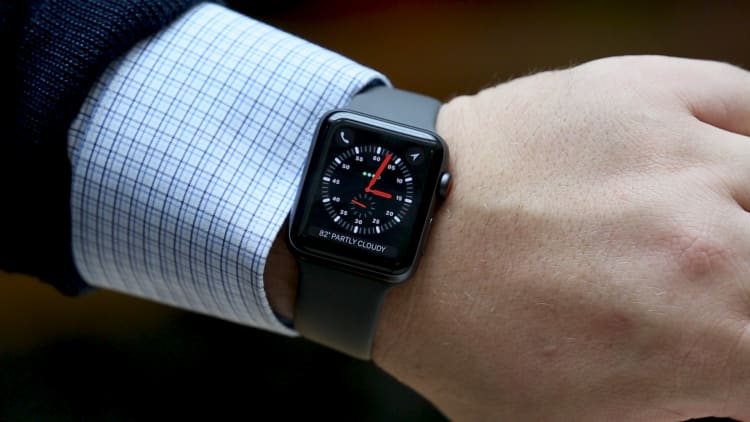
Older Americans are optimistic about health and fitness-tracking wearables, but are struggling to use them.
Millions of baby boomers could benefit from increased motivation to exercise and better nutrition. They are also the ideal targets for new features that aim to screen for health conditions that are more common with age. Apple, for instance, is working with Stanford on a study to use the Apple Watch to detect a heart rhythm disorder called atrial fibrillation that occurs in 3 to 5 percent of people over 65.
Still, studies have shown that these devices have a long way to go before they appeal to the boomer generation.
Just ask my own mother (below), who wore a Fitbit "Ionic" and Apple Watch Series 3 for a week. She found both devices fun, particularly the easier-to-use Fitbit, but missed her Piaget timepiece.
The "gamified" features like the rewards for meeting fitness goals also didn't appeal.
When I asked her, "Is the idea of closing your rings getting you to walk more every day?" she retorted, "No, what's getting me to walk is I need to go somewhere."
This lack of adoption doesn't extend to other technologies, like the iPhone. My mother is rarely seen without one and frequently schools me in how to get more Instagram "likes" for my posts.
Research published in the Journal of the American Medical Association found that few seniors used digital health technologies, but more than three-quarters of those surveyed had a cell phone they used regularly.
Appealing to seniors
A 2015 study from the interest group AARP asked consumers over the age of 50 to sport a wearable for six weeks and report back on their experiences.
Despite high levels of interest from this population, which accounts for 1 in 3 Americans, many reported usability issues. Eighty-nine percent shared frustrations with the setup process, and many also struggled with the data inaccuracy, the lack of instructions, and the challenges with putting on the device.
Most damning of all is that many users didn't even finish the six-week study, opting to abandon their wearable after a month (the average participation was 32 days).
So what would it take to bolster adoption? According to the study's authors (and in concurrence with my own mother's suggestions), seniors wanted:
- Easier-to-understand and more detailed instructions
- Robust syncing capabilities
- Comfort while wearing the tracker
- Timely, relevant notifications (medication reminders, appointments, and so on)
- A display with instant information access, like the time
- Incorporation of other sensors that track health conditions
Many of these features have improved since 2015, such as integration with popular blood sugar trackers, but some of these challenges remain.
For Jeff Makowka, formerly of AARP and now a consultant specializing in health technology for the aging population, making wearables more usable for older Americans is a "no-brainer."
As Makowka points out, many of the leading insurance companies, including Aetna, have expressed interest in health-tracking wearables, and are willing to subsidize their cost. And that's an important sales channel for Apple, Fitbit and the other leading wearable makers.
"I can't quite figure out why a ton of effort hasn't been made into making these devices simple and engaging so older folks will see the benefit of sharing their health data," he said. That means better peace of mind for caregivers and family members, especially as these wearables start to track far more than steps, Makowka explains.
Other experts say that wearables will primarily appeal to early adopters and fans of the brand, who tend to skew younger, until they become virtually invisible by getting woven into clothing.
A watch is not an ideal form factor for this age group, explains Sage Bionetworks' chief commons officer John Wilbanks.
"You have to make this jump if you're older from the watch being a single function tool to multi-function," he explained. "Meanwhile, I have younger friends who had never worn a watch."


